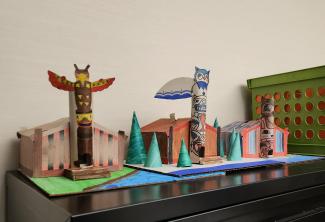Media Contact
Katy Payne she/her
360-764-0201
Do you know what’s noteworthy about Washington state’s high school graduation requirements? It’s Washington state history.
From seventh to 12th grade, all students in Washington State are required to take one semester of Washington state history. This course covers the geography, history, government, economy, and people of Washington State.
I took Washington state history in my freshman year. As I moved from South Korea that year, I did not know much about Washington state. However, during the six months I spent in Washington state history class, I realized how much my appreciation for Washington state itself had grown. My view of Washington shifted from simply a “rainy state” to a captivating, beautiful state with diverse geographies, organisms, and culture.
What We Learn in Washington State History Class
- Indigenous tribes such as Coast Salish, Spokane, and Yakama
- Conflicts that Native Americans face today, such as getting back their ownership of watershed and fish
- Japanese-American Incarceration during World War II
- Process of a bill becoming a law
- Constitution of Washington State
- Diverse geography such as the Cascade Range and Columbia River
- Native organisms such as Grand Fir, Baneberry, and Fern
What I Derived from the Class
Two of the projects I worked on in Washington state history class were a Haida house and a brochure about Pacific County. The Haida house was a traditional Native American house. It was made of big healthy cedar trees and averaged 25 to 33 meters long and 17 meters wide. Haida houses had totem poles in the front of the house, with animals representing the clan carved on them. It could be usually found along the Northwest Coast (Simon Fraser University).

I made the brochure about Pacific County while learning about the different counties in our state. After making the brochure, we, as a class, shared brochures we made for different counties. Through this project, I was able to gain a deeper understanding of each county and its history. I learned that each county has a unique local history due to its distinct geographies, natural resources, and peoples, which add to the state’s diversity.
One of the interesting concepts that had the most impact on me in the class was about Native peoples and how they relate to salmon. Salmon have occupied a large part of their spiritual, economic, and cultural life. Native tribes in the Pacific Northwest even identify themselves as Salmon People, according to the National Museum of the American Indian. They consider salmon to be the most important gift from the Creator and commemorate their sacred salmon on special.
Unfortunately, the people who were on the land first are having some conflicts with non-Indigenous people over watershed ownership and fish (Watersheds BC). Moreover, due to the development of industry and the destruction of nature, salmon are losing their habitats, according to the Washington State Recreation and Conservation Office’s “State of Salmon in Watersheds” report.
After looking through their situation and learning more about their wondrous life in the class, I studied more about them. I realized how much the salmon population is decreasing and that I have to take action to protect and conserve salmon, which are the special ancestral heritage of Native American tribes.
As a result, I started volunteering at a salmon hatchery to protect salmon. My interest in and affection for Native culture and salmon grew more and more as I found out more information about them and shared it with the public.
Also, with a closer look at salmon, I realized salmon is a magnificent fish. What impressed me the most was their long arduous journey from saltwater to freshwater, where they were born many years ago, to spawn. Their strong persistence to continue their generation came to me astonishingly and inspired my attitude towards my goals.
The question of how they found the routes is not clearly solved, but Earth’s magnetic field and their strong sense of smell contribute to their navigating skills (U.S. Geological Survey). I think this is also the wonder and beauty of nature, that they are able to return to their home water to spawn, where it is more adequate for them in terms of the survival of their offspring.
I am going to keep advocating for protecting our fish, salmon, by educating the public about them at the hatchery. I want to raise awareness about salmon and gather more people who care about fish to take action to preserve the generations of salmon together.
Overall, the Washington state history class was meaningful to me in helping me discover the natural beauty of the state and different people. It has inspired me to work for native people and conserve and protect natural environments as unharmed as possible. Since Washington state history class in high school is especially for the people who transferred from other countries or states, I believe it indeed helped me and my classmates to learn about this new state we are living in and connect with the state in a deeper way. I am grateful for taking this class.
For More Information
Editor’s Note: OSPI aims to elevate the authentic experiences of the students in Washington’s K–12 public schools. This story was written by a Washington state high school student participating in OSPI’s Student Stories Program. The author’s opinions, beliefs, and viewpoints do not necessarily reflect those of OSPI, and publication of this story does not constitute OSPI’s approval or endorsement of its contents. With questions, please contact OSPI’s Communications team at commteam@k12.wa.us.






